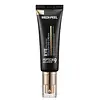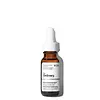What's inside
What's inside
 Key Ingredients
Key Ingredients

 Benefits
Benefits

 Concerns
Concerns

 Ingredients Side-by-side
Ingredients Side-by-side

Water
Skin ConditioningMethylpropanediol
SolventCaprylic/Capric Triglyceride
MaskingGlycerin
HumectantDimethicone
EmollientNiacinamide
SmoothingPentaerythrityl Tetraisostearate
EmollientCyclopentasiloxane
EmollientCetearyl Alcohol
EmollientCetearyl Olivate
Cyclohexasiloxane
EmollientSorbitan Olivate
EmulsifyingGlyceryl Stearate
EmollientButyrospermum Parkii Butter
Skin ConditioningHydroxypropyl Methylcellulose
Emulsion StabilisingPEG-100 Stearate
Pullulan
Hydroxyacetophenone
AntioxidantHelianthus Annuus Seed Oil
EmollientSodium Polyacrylate
AbsorbentArginine
MaskingCarbomer
Emulsion StabilisingSodium Acrylate/Sodium Acryloyldimethyl Taurate Copolymer
Emulsion StabilisingCetearyl Glucoside
EmulsifyingIsohexadecane
EmollientJuniperus Communis Fruit Extract
PerfumingEucalyptus Globulus Leaf Extract
PerfumingTrehalose
HumectantEthylhexylglycerin
Skin ConditioningXanthan Gum
EmulsifyingPolysorbate 80
EmulsifyingPorphyridium Cruentum Extract
Skin ConditioningParfum
MaskingGlycine Soja Oil
EmollientAdenosine
Skin ConditioningSodium Hyaluronate
HumectantDisodium EDTA
Sorbitan Oleate
EmulsifyingMalt Extract
Skin ProtectingPropanediol
SolventSodium Hyaluronate Crosspolymer
HumectantBixa Orellana Seed Oil
EmollientHydrolyzed Glycosaminoglycans
HumectantOlea Europaea Leaf Extract
PerfumingGlycyrrhiza Glabra Root Extract
BleachingTaraxacum Officinale Leaf Extract
Skin ConditioningMagnolia Officinalis Bark Extract
AntimicrobialFructan
Skin ConditioningHydrolyzed Elastin
EmollientHydrolyzed Collagen
EmollientHydrogenated Polyisobutene
EmollientGlyceryl Polymethacrylate
Benzyl Glycol
SolventTocopherol
AntioxidantPropylene Glycol
HumectantRosa Damascena Flower Extract
MaskingRhodiola Rosea Root Extract
EmollientHydrolyzed Hyaluronic Acid
HumectantGinkgo Biloba Leaf Extract
Skin ConditioningZanthoxylum Piperitum Fruit Extract
Skin ConditioningPulsatilla Koreana Extract
Skin ConditioningButylene Glycol
Humectant1,2-Hexanediol
Skin ConditioningRaspberry Ketone
MaskingPalmitoyl Tripeptide-5
Skin ConditioningHyaluronic Acid
HumectantPalmitoyl Tetrapeptide-7
Skin ConditioningAnemarrhena Asphodeloides Root Extract
Skin ConditioningAcetyl Hexapeptide-8
HumectantCopper Tripeptide-1
Skin ConditioningPalmitoyl Oligopeptide
CleansingPalmitoyl Tripeptide-1
Skin ConditioningOligopeptide-29
AntioxidantOligopeptide-32
AntiseborrhoeicPalmitoyl Pentapeptide-4
Skin ConditioningWater, Methylpropanediol, Caprylic/Capric Triglyceride, Glycerin, Dimethicone, Niacinamide, Pentaerythrityl Tetraisostearate, Cyclopentasiloxane, Cetearyl Alcohol, Cetearyl Olivate, Cyclohexasiloxane, Sorbitan Olivate, Glyceryl Stearate, Butyrospermum Parkii Butter, Hydroxypropyl Methylcellulose, PEG-100 Stearate, Pullulan, Hydroxyacetophenone, Helianthus Annuus Seed Oil, Sodium Polyacrylate, Arginine, Carbomer, Sodium Acrylate/Sodium Acryloyldimethyl Taurate Copolymer, Cetearyl Glucoside, Isohexadecane, Juniperus Communis Fruit Extract, Eucalyptus Globulus Leaf Extract, Trehalose, Ethylhexylglycerin, Xanthan Gum, Polysorbate 80, Porphyridium Cruentum Extract, Parfum, Glycine Soja Oil, Adenosine, Sodium Hyaluronate, Disodium EDTA, Sorbitan Oleate, Malt Extract, Propanediol, Sodium Hyaluronate Crosspolymer, Bixa Orellana Seed Oil, Hydrolyzed Glycosaminoglycans, Olea Europaea Leaf Extract, Glycyrrhiza Glabra Root Extract, Taraxacum Officinale Leaf Extract, Magnolia Officinalis Bark Extract, Fructan, Hydrolyzed Elastin, Hydrolyzed Collagen, Hydrogenated Polyisobutene, Glyceryl Polymethacrylate, Benzyl Glycol, Tocopherol, Propylene Glycol, Rosa Damascena Flower Extract, Rhodiola Rosea Root Extract, Hydrolyzed Hyaluronic Acid, Ginkgo Biloba Leaf Extract, Zanthoxylum Piperitum Fruit Extract, Pulsatilla Koreana Extract, Butylene Glycol, 1,2-Hexanediol, Raspberry Ketone, Palmitoyl Tripeptide-5, Hyaluronic Acid, Palmitoyl Tetrapeptide-7, Anemarrhena Asphodeloides Root Extract, Acetyl Hexapeptide-8, Copper Tripeptide-1, Palmitoyl Oligopeptide, Palmitoyl Tripeptide-1, Oligopeptide-29, Oligopeptide-32, Palmitoyl Pentapeptide-4
Water
Skin ConditioningGlycerin
HumectantButylene Glycol
HumectantPropanediol
SolventDipropylene Glycol
HumectantAcetyl Glucosamine
Skin ConditioningNiacinamide
SmoothingPalmitoyl Tripeptide-38
Skin ConditioningAcetyl Tetrapeptide-5
HumectantMyristoyl Nonapeptide-3
Skin ConditioningDipeptide Diaminobutyroyl Benzylamide Diacetate
Skin ConditioningCaffeine
Skin ConditioningEpigallocatechin Gallatyl Glucoside
AntioxidantGallyl Glucoside
AntioxidantFraxinus Excelsior Bark Extract
Skin ConditioningSilanetriol
Arginine
MaskingPentylene Glycol
Skin ConditioningHydroxymethoxyphenyl Decanone
Skin ConditioningPropyl Gallate
AntioxidantMaltodextrin
AbsorbentHydroxypropyl Cyclodextrin
MaskingHydroxyethylcellulose
Emulsion StabilisingXanthan Gum
EmulsifyingCitric Acid
BufferingGlycolic Acid
BufferingSodium Citrate
BufferingPolysorbate 20
EmulsifyingTrisodium Ethylenediamine Disuccinate
Dehydroacetic Acid
PreservativeEthylhexylglycerin
Skin ConditioningBenzyl Alcohol
PerfumingPhenoxyethanol
PreservativeChlorphenesin
AntimicrobialWater, Glycerin, Butylene Glycol, Propanediol, Dipropylene Glycol, Acetyl Glucosamine, Niacinamide, Palmitoyl Tripeptide-38, Acetyl Tetrapeptide-5, Myristoyl Nonapeptide-3, Dipeptide Diaminobutyroyl Benzylamide Diacetate, Caffeine, Epigallocatechin Gallatyl Glucoside, Gallyl Glucoside, Fraxinus Excelsior Bark Extract, Silanetriol, Arginine, Pentylene Glycol, Hydroxymethoxyphenyl Decanone, Propyl Gallate, Maltodextrin, Hydroxypropyl Cyclodextrin, Hydroxyethylcellulose, Xanthan Gum, Citric Acid, Glycolic Acid, Sodium Citrate, Polysorbate 20, Trisodium Ethylenediamine Disuccinate, Dehydroacetic Acid, Ethylhexylglycerin, Benzyl Alcohol, Phenoxyethanol, Chlorphenesin
 Reviews
Reviews

Ingredients Explained
These ingredients are found in both products.
Ingredients higher up in an ingredient list are typically present in a larger amount.
Arginine is an amino acid that is important for human development. Your body uses is it to produce hair keratin and skin collagen.
As a cosmetic ingredient, Arginine has antioxidant properties and can also help repair damaged skin. This ingredient is derived either synthetically or from animals.
Arginine isn't fungal acne safe when used in the presence of other lipids (fats, fatty acids, oils, esters, etc). Oils and fats occur naturally within the skin, so take caution when using Arginine if you're prone to fungal acne.
Learn more about ArginineButylene Glycol (or BG) is used within cosmetic products for a few different reasons:
Overall, Butylene Glycol is a safe and well-rounded ingredient that works well with other ingredients.
Though this ingredient works well with most skin types, some people with sensitive skin may experience a reaction such as allergic rashes, closed comedones, or itchiness.
Learn more about Butylene GlycolEthylhexylglycerin (we can't pronounce this either) is commonly used as a preservative and skin softener. It is derived from glyceryl.
You might see Ethylhexylglycerin often paired with other preservatives such as phenoxyethanol. Ethylhexylglycerin has been found to increase the effectiveness of these other preservatives.
Glycerin is already naturally found in your skin. It helps moisturize and protect your skin.
A study from 2016 found glycerin to be more effective as a humectant than AHAs and hyaluronic acid.
As a humectant, it helps the skin stay hydrated by pulling moisture to your skin. The low molecular weight of glycerin allows it to pull moisture into the deeper layers of your skin.
Hydrated skin improves your skin barrier; Your skin barrier helps protect against irritants and bacteria.
Glycerin has also been found to have antimicrobial and antiviral properties. Due to these properties, glycerin is often used in wound and burn treatments.
In cosmetics, glycerin is usually derived from plants such as soybean or palm. However, it can also be sourced from animals, such as tallow or animal fat.
This ingredient is organic, colorless, odorless, and non-toxic.
Glycerin is the name for this ingredient in American English. British English uses Glycerol/Glycerine.
Learn more about GlycerinNiacinamide is a multitasking form of vitamin B3 that strengthens the skin barrier, reduces pores and dark spots, regulates oil, and improves signs of aging.
And the best part? It's gentle and well-tolerated by most skin types, including sensitive and reactive skin.
You might have heard of "niacin flush", or the reddening of skin that causes itchiness. Niacinamide has not been found to cause this.
In very rare cases, some individuals may not be able to tolerate niacinamide at all or experience an allergic reaction to it.
If you are experiencing flaking, irritation, and dryness with this ingredient, be sure to double check all your products as this ingredient can be found in all categories of skincare.
When incorporating niacinamide into your routine, look out for concentration amounts. Typically, 5% niacinamide provides benefits such as fading dark spots. However, if you have sensitive skin, it is better to begin with a smaller concentration.
When you apply niacinamide to your skin, your body converts it into nicotinamide adenine dinucleotide (NAD). NAD is an essential coenzyme that is already found in your cells as "fuel" and powers countless biological processes.
In your skin, NAD helps repair cell damage, produce new healthy cells, support collagen production, strengthen the skin barrier, and fight environmental stressors (like UV and pollution).
Our natural NAD levels start to decline with age, leading to slower skin repair, visible aging, and a weaker skin barrier. By providing your skin niacinamide, you're recharging your skin's NAD levels. This leads to stronger, healthier, and younger looking skin.
Another name for vitamin B3 is nicotinamide. This vitamin is water-soluble and our bodies don't store it. We obtain Vitamin B3 from either food or skincare. Meat, fish, wheat, yeast, and leafy greens contain vitamin B3.
The type of niacinamide used in skincare is synthetically created.
Learn more about NiacinamidePropanediol is an all-star ingredient. It softens, hydrates, and smooths the skin.
It’s often used to:
Propanediol is not likely to cause sensitivity and considered safe to use. It is derived from corn or petroleum with a clear color and no scent.
Learn more about PropanediolWater. It's the most common cosmetic ingredient of all. You'll usually see it at the top of ingredient lists, meaning that it makes up the largest part of the product.
So why is it so popular? Water most often acts as a solvent - this means that it helps dissolve other ingredients into the formulation.
You'll also recognize water as that liquid we all need to stay alive. If you see this, drink a glass of water. Stay hydrated!
Learn more about WaterXanthan gum is used as a stabilizer and thickener within cosmetic products. It helps give products a sticky, thick feeling - preventing them from being too runny.
On the technical side of things, xanthan gum is a polysaccharide - a combination consisting of multiple sugar molecules bonded together.
Xanthan gum is a pretty common and great ingredient. It is a natural, non-toxic, non-irritating ingredient that is also commonly used in food products.
Learn more about Xanthan Gum